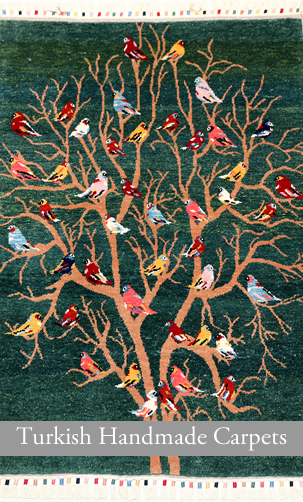Motifs on Kilims
There are many motifs on kilim, and motifs are mainly familiar object such as nature and animals. The same motif has different designs depend on its producing areas and tribes. Especially, in Turkey, it is said that each motifs are affected by Shamanism. We introduce many meanings in each motif briefly. Since its artisans have been mainly women, there are many motifs meaning wishes peculiar to women.
Elibelinde: a woman standing with her hands on her hips. This motif means motherhood that guards and devotes herself to her child. Also means prolificity and fertility.
Kocbiynuzu (sheep’s horn): means power, health, happiness, male fertility, and power protecting one’s life.
Ejderha (Dragon): An imaginary creature believed living in sacred nature (sea, sky, mountain, and forest). It symbolizes power, while is regarded as a guardian.
Sacbagi (hair ornament): A young woman’s hope for marriage. There is a legend that a young woman weaves this motif into kilim and her mother realizes her daughter’s hope for marriage.
Kurt Agzi (wolf’s mouth): means protection of nomads and farm animals against beasts in nature.
Gul (rose): A white rose symbolizes love, red one is passion, and a wild rose means longing.
Kupe (Erring): An ardent desire for marriage
Akrep (scorpion): means protection of nomads and farm animals against beasts in nature. Since scorpion has an instinct that kill itself in danger by own sting, it symbolizes pride and liberty.
Deve (camel): Camel has been the most important creature in traveling and transportation. This motif means appreciation for camels, and also means domestic peace and praying for happiness.
Hayat Agaci (tree of life): It was believed that the huge and tall tree of life was standing on the center of universe from the begging of the world, which knew world’s mysteries and had permanent strong power. The tree rise to the sky and its appearance is compared to a bridge from birth to death. This motif has been often described on Anatolia kilims and means happiness in Heaven and immortal life. The bird on the branch of the tree is a bird of paradise, which means an attendant to Heaven.
Aile Sembolu (family crest): means ties. Each family and tribe has own crest, which is used as motif on kilims and carpets.
Ucan kus (flying bird): A flying bird brings good news. Some say that this motif originated from a carrier pigeon
Ev (house, tent) means domestic peace.
Nar (pomegranate): A pomegranate has been regarded as a sacred fruit in paradise. This motif symbolizes pray that a young woman’s marriage may be happy forever. In addition, it means fortune, fertility, and longevity.
Yaprak (leaf): means life and death. A human life had been compared to a leaf, which come into bud (birth), and finally fall out (death). This motif also means an immortal spirit.
Terazai (balance): means guilt, good deeds, and justice.
Mihrab: This motif is the arch of a mosque. When a Muslim prays, he / she turns the point of the arch on his / her kilim into the direction of Mecca.
So yolu (stream): means a zigzag line of a stream. Water is a basis of human life.
Yoldiz (star):This Eight stars is called the stars of Solomon and the jewels of Muhammad. It means fertility, pray for happiness, and a spiritual revelation.
S: means a key and a hook and implies strong tie.
Islamin 5 Sarti (Islamic five dots): means five duties of Islam.
1. Five prays in a day.
2. Ramadan
3. Helping the poor
4. Believing in Muhammad.
5. A pilgrimage to Mecca if possible
Nohun Gemisi (Noah’s ark): This motif often appears on kilims made in the areas around the Mount Ararat, where the legend of Noah’s ark is believed. In the legend, Noah gets many animals on board, so animal motifs characterize this motif. It means the natural environment around the artisans and the importance of their religion.
Goz (eye): The protection against the evil, crimes, harms, and diseases.
Sevgi Kus (bird) : Two birds look at each other in this motif. It is called “Love Birds” and means the true love.
Muska (triangle): The protection against the evil and misfortune. It also means fertility.
Kartal (eagle): As a ruler of the sky, this motif symbolizes the sky. It means healthy, sensible life. People had been believed that the eagle was the king of birds and protect them, so the eagle facing right means the divinity and protection.
Basak (wheat): A grain on the ground brings numerous amount of wheat, so it means fertility and regeneration. This motif shows women artisans wish for a bountiful harvest in her family.
Kaz: (goose’s feet): Goose’s web is triangle. Triangle has been regarded as the protection against the evil and deliverer of fortune and Goose’s feet symbolizes gifts from God (divinity, production, fertility).
Ok (bow and arrow): means bravery and hero. Women artisans described a bow and arrow on the kilims with the wish that their husbands and lovers were strong and brave.
Insan (human): This motif comes from the artisan herself and her family. It means human ties.









